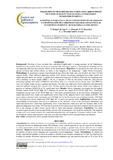| dc.contributor.author | Muigai, Pauline | |
| dc.contributor.author | Agevi, Humphrey | |
| dc.contributor.author | Otuoma, John | |
| dc.contributor.author | Muyekho, Francis | |
| dc.contributor.author | Onyango, Christine | |
| dc.contributor.author | Ayaga, George | |
| dc.date.accessioned | 2023-10-25T14:21:20Z | |
| dc.date.available | 2023-10-25T14:21:20Z | |
| dc.date.issued | 2023-07-26 | |
| dc.identifier.uri | http://doi.org/10.56369/tsaes.4774 | |
| dc.identifier.uri | https://www.revista.ccba.uady.mx/ojs/index.php/TSA/article/view/4774/2103 | |
| dc.identifier.uri | http://ir-library.mmust.ac.ke:8080/xmlui/handle/123456789/2379 | |
| dc.description.abstract | Background: Growing of trees on-farms has contributed significantly in easing pressure on the Kakamega–Nandi Forest Ecosystem. There are however concerns that Eucalyptus species is becoming the dominant tree in this landscape and may have adverse effects on the environment. Objectives: To determine the trade-offs in tree species selection and carbon offsets on farms in the margins of the Kakamega - Nandi Forest Ecosystem. Methodology: It employed a nested experimental design where the study area was divided into three 3x1 km sentinel blocks. Three different landscape models were chosen: Eucalyptus dominated tree stand, mixed tree stands and pure native tree stands. A sample plot comprised a main plot of 20m by 10m plot for measuring trees with a diameter at breast height (DBH) ≥ 10 cm, a sub-plot of 10m by 5m nested within the main plot for measuring saplings and shrubs of DBH less than 10cm. Data was collected on tree species type, stem DBH for trees, tree height, counts of trees, saplings and shrubs. The data was subjected to both exploratory and inferential statistical analysis using R Gui Version 4.2.1. Woody species diversity and carbon stocks were subjected to analysis of variance (ANOVA) at 5% significance level. Results: Native dominated tree stands had the highest biomass carbon (0.50-512.84 MgC ha-1) followed by mixed tree stands (0.10-110.82 MgC ha-1). Eucalyptus dominated was the least (0.10- 68.58 MgC ha-1). The above ground biomass in the Eucalyptus dominated tree stands and mixed trees stands was significantly lower than in the adjacent native trees stands (p=0.001). The mean carbon estimated in the treatments was 2.62 MgC ha-1 in the Eucalyptus trees dominated stands, 3.09 MgC ha-1 in mixed trees species stands and 19.05 MgC ha-1 in native tree species stand. Implications: Increase in the concentration of Eucalyptus trees led to a reduction in tree diversity. Trees in the Eucalyptus dominated tree stand and mixed trees stand had significantly lower stem diameters, basal area and tree biomass than in the adjacent indigenous trees stand. The fast rate of growth of Eucalyptus trees may have ensured that the trees grow fast at the expense of other woody species due to water and nutrient competition. Conclusion: The study revealed a general trend of increasing biomass carbon with increasing tree size in all the treatments. The majority of large trees were found in native tree stand indicating that they store majority of biomass carbon stocks. Across the treatment, carbon sequestration in the trees was directly related to above ground biomass production. | en_US |
| dc.language.iso | en | en_US |
| dc.publisher | Tropical and Subtropical Agroecosystems | en_US |
| dc.subject | TRADE-OFFS, TREE, SPECIES, SELECTION, CARBON ,OFFSET, FARMS, ADJACENT, FOREST, ECOSYSTEM | en_US |
| dc.title | TRADE-OFFS IN TREE SPECIES SELECTION AND CARBON OFFSET ON FARMS ADJACENT TO KAKAMEGA-NANDI FOREST ECOSYSTEM IN KENYA | en_US |
| dc.type | Article | en_US |

